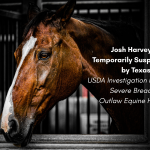Learn how to manage Equine Metabolic Syndrome (EMS) with expert tips on prevention, treatment, and proper care. Discover the role of age, insulin resistance, and effective feeding practices in safeguarding your horse’s health.
What Is Equine Metabolic Syndrome (EMS)?
Equine Metabolic Syndrome (EMS) is a condition impacting how horses absorb and process sugars. It's characterized by an inability to respond to insulin, similar to Type 2 diabetes in humans. When an EMS-affected horse consumes carbohydrate-rich meals, its body produces elevated insulin levels that are slow to return to baseline. EMS also increases the risk of obesity, laminitis, and abnormal fat deposits.
Signs and Symptoms of EMS
Horses with EMS are typically overweight, displaying fat deposits over the neck, ribs, topline, base of the tail, and above the eyes. Signs of EMS-related laminitis in the hooves may include abnormal hoof growth rings and coffin bone rotation, which can be identified through X-rays. Additional symptoms include:
- Excessive drinking and urination
- Loss of muscle mass
- Changes in appetite and exercise tolerance
- Abnormal ovarian activity (estrous cycles) in mares
EMS Diagnostics
Bloodwork conducted by your veterinarian is the most effective screening tool for EMS and insulin dysregulation. Common blood tests include Baseline Insulin and Glucose, the Oral Sugar Test (OST), the IV Glucose Tolerance Test (IVGTT), and Baseline Leptin or Baseline Adiponectin. Blood samples are usually taken first thing in the morning, before horses receive grain rations, to prevent glucose spikes.
- Baseline Insulin and Glucose: High insulin levels are indicative of EMS. A blood insulin concentration above 20 uIU/mL suggests insulin resistance. Additionally, EMS horses typically have blood glucose (sugar) concentrations that are normal or slightly elevated. Previous recommendations included fasting the horse the night before the test; however, this is no longer advised due to a high rate of false negatives. Testing should occur with the horse having access to pasture or hay but no other feed. This forage should be provided the night before and continued on the test day. The test should also be performed in a low-stress environment, as insulin levels are affected by stress and pain.
- Oral Sugar Test (OST): The OST is a familiar test for many horse owners. It involves feeding a sugary solution (typically corn syrup) to a horse after a three- to 12-hour fast. Blood is collected 60 to 90 minutes after administering the solution. An insulin concentration exceeding 60 uIU/mL is considered abnormal.
- IV Glucose Tolerance Test (IVGTT): This test requires a blood sample before intravenous (IV) administration of dextrose (sugar), with additional collections taken at one, 15, 30, 45, and 60 minutes post-injection. Blood is evaluated for glucose and insulin values. In healthy horses, concentrations return to normal quickly, whereas EMS-affected horses will show prolonged elevation.
- Baseline Leptin and Adiponectin: Adipose, or fat cells, produce the hormone leptin. Leptin levels are higher in the blood of EMS-affected horses. Adiponectin is another fat-produced hormone that increases insulin sensitivity and is typically low in EMS horses. EMS-affected horses will have an adiponectin range from 0.7 to 4.9 ug/mL.
Treatment and Management of EMS
Dietary Management and Exercise: The initial step in managing EMS is to modify your horse’s feeding program to facilitate weight loss. Horses with EMS should be fed carbohydrate-restricted diets, meaning grains, fruits, vegetables, and sugary treats should be eliminated. Pasture access should be restricted, or removed entirely, until a normal body weight is achieved. Forage should also be analyzed to determine its starch and sugar content. The hydrolyzable carbohydrate (HC) fraction fed to EMS horses should be less than 10% of dry matter (DM).
Exercise is also crucial for EMS horses as it helps reduce inflammation and blood insulin concentrations. Designing an appropriate exercise program depends on your horse’s body condition score (BCS), fitness level, and hoof stability if laminitis is present.
Medications: When diet and exercise alone are insufficient, drug therapy may be necessary. Your veterinarian might recommend several classes of medications, including:
- Metformin
- Levothyroxine
- Pergolide
- SGLT2 inhibitors
Always consult with your veterinarian to determine the most effective drug for your horse.
Recovery and Conclusion
Horses with EMS should undergo regular veterinary check-ups to monitor the effectiveness of management strategies and assess insulin levels. It is possible to reverse hyperinsulinemia and prevent recurrence. However, horses can relapse, particularly as they age. Research indicates that insulin resistance correlates with age, with horses between five and 16 years old being most susceptible to EMS. Incorporate optimal management practices as early as possible to minimize the possibility of EMS. When in doubt, consult your equine nutritionist, veterinarian, and Extension Agent to formulate a comprehensive plan.
For more insights like this one subscribe to our premium digital monthly subscription here!









